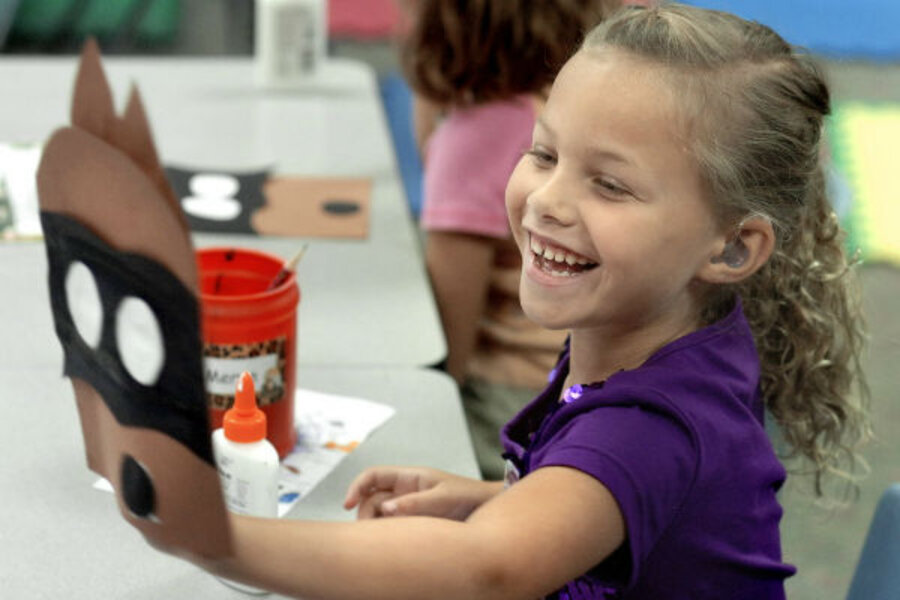Kindergarten teacher: August dreams, the best laid lesson plans
Loading...
| Philadelphia
My daughter Hilary is going into the family business: teaching.
In September, she will welcome her first group of kindergartners in her first classroom that is all her own. So she is encountering the August teacher dreams for the first time, preparing her room with decorations (a T-Rex model named Edwina! A science experiment center!), posters, crayons, desks, and, most importantly, curriculum and classroom routines.
She e-mailed one morning from her classroom. Her little dog Betty was her only companion, and Hilary was busying herself in preparation and the quietude of a kindergarten room awaiting kindergartners – or, as John McPhee might put it, “the silence of [kindergartners] intending to appear.”
The essential question came to mind. “What am I going to teach these kids?” asked Hilary.
I know many a veteran teacher that asks the same question in August, dreams the same August dreams unique to teachers and copes with the insecurities and uncertainties of the novice teacher – the novices in themselves. I too am a veteran teacher, as is my wife. Hilary comes by the trade almost by osmosis. She has seen us pass through 30 Augusts, watched our preparation and trepidation. Certainly, her resources are within, awaiting detection.
I thought for a minute, and then wrote back: “It’s easy. Teach this: Hold hands. Stick together. Look both ways. Flush when you’re done. A-B-C-D-E-F-G. Be nice. Ask permission. Listen. Take turns. Say thank you. Be reverent. Use the 25 rules of civility. Done.”
Easy? Come to think of it, this isn’t just the kindergarten curriculum. It’s the Life Curriculum. But if the mindset is established in kindergarten, it becomes the inauguration of crucial habits of mind, heart, and hand that will stand the student in good stead long beyond the playground and sandbox – as they have for Hilary, and for her parents.
When I walked Hilary to her own kindergarten class at her new school – my school – I remember the frisson of parental uncertainties, so different from the customary teacher feelings. Now I was entrusting my child to my colleagues; I was entering a new “school” of fatherhood. What will they teach these kids? I wondered. I understood the faith and trust offered me by the parents of my students. Now I am dropping her off in another respect, at the portal of her career.
I was reminded of another inaugural moment, many years ago. I’ve always loved the poem by Howard Nemerov that an experienced teacher shared with me when our son entered kindergarten. In “September, First Day of School,” the father in Nemerov has arrived at the same door of his own letting-go as a boy, a lifetime ago, while also realizing that he will return, still the student but with the pangs of the parent, for the same young man finishing 18 years hence.
He thinks of the incredible act of trust it is to place him in the hands of his teachers, trust in the very functions and foibles of school itself. It’s a hand-off that we all make every year, with greater and greater ease and less ceremony after that first big day. The first time is the biggest hand-off. Nemerov summons a humble desire:
May the fathers he finds
Among his teachers have a care of him
More than his father could. How that will look
I do not know, I do not need to know.
Even our tears belong to ritual.
But may great kindness come of it in the end.
I see it as a peculiar privilege of people who work in schools to enjoy this inaugural day of our own every year as we watch the newcomers enter the schoolhouse doors. I had 22 of my own student first days – 18 with each of my children, not counting college – and I now contemplate my 30th as a teacher.
But each time I am new. And watching over the shoulder of my daughter, the new teacher, gives a special pleasure and pride. It’s a new view. The son is father to the man; the student to the teacher; the school head to the youngest child ... and his own daughter, now walking herself to her new schoolhouse – and so on. Doorway upon doorway. We await the appearance of ourselves, over and over. This, too, is what we’ll teach the kids. As we hold hands, stick together. Be reverent.






